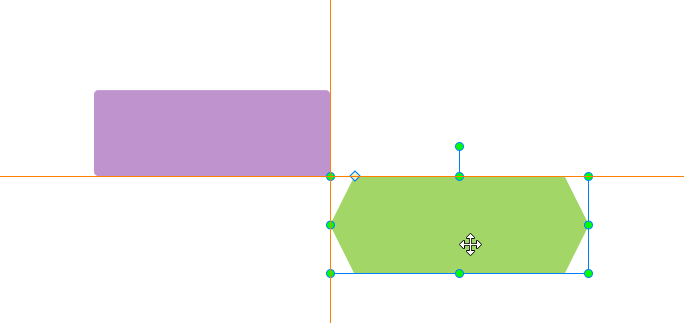Snapping modes help you easily align objects whether they are on the Canvas or in the Timeline. ActivePresenter 9 offers users 4 snapping modes including Canvas Snapping, Timeline Snapping, Cursor Snapping, and Container Snapping. Let’s learn about them in today’s tutorial.
You can easily find out these 4 functions in the View tab of the app.

We’ll explore them all through the table of contents:
Before going ahead, click the button below to download the latest version of ActivePresenter:
Canvas Snapping
From version 9, ActivePresenter enhances users’ experience with the Canvas Snapping function. It contains three tools, namely Gridlines, Guides, and Smart Guides. For detailed information, refer to the article Align Objects Using Canvas Snapping.
When the Smart Guides checkbox is selected, as soon as an object comes in the vicinity of another object or the Canvas, it will make a tiny jump to match the edge of each other. Vertical and/or horizontal orange lines will appear to visualize the alignment. This option is selected by default.

You can also select the Gridlines and Guides checkboxes to place the object more precisely on the Canvas. If you want to disable the Canvas snapping, deselect all the checkboxes in the Canvas Snapping function. Or, temporarily holding down ALT when you drag or resize objects on the Canvas.
Timeline Snapping
ActivePresenter 9’s Timeline Snapping mode enables you to align various objects with greater ease and precision on the timeline. In general, it works the same way as the Canvas Snapping mode. When this mode is on, as soon as a moving “snappable” object comes into the vicinity of another “snappable” object, it will make a tiny jump to match the timestamp of the other object.

Timeline snapping applies to the following timeline items:
- In the range area: Playhead, start marker, and end marker of the range.
- In the objects’ time bars: Starting and ending edge, all markers inside the object time bar (For example, animation start time, the end edge of animation duration, or the starting and ending point of insert time).
- Others: The starting and ending point of the slide.
Timeline snapping is enabled by default. To disable it, access the View tab > click on Timeline Snapping. Or temporarily disable this function by holding down ALT when you drag an object’s time bar.
Notes:
- The “other object” may be any object time bar in the Timeline pane whether it is placed in any row or any position.
- The vertical orange line indicates the snapping of the object time bars in the Timeline pane. Any object’s time bar can snap to others when you drag it along the timeline.
Cursor Snapping
Cursor snapping mode is designed for the cursor path, especially when you record software simulations. It helps move the corresponding point in the previous/next slide to ensure a smooth mouse movement.
If you don’t want the cursor path to move continuously between slides, click the View tab and turn off Cursor Snapping.
In rare cases, the cursor path can be out of sync. For example, when you delete a slide that is in the middle or delete the cursor path in that slide. This results in an abrupt movement of the mouse cursor in the rendered presentation when the slide changes. To avoid this, you can again stitch the ends of cursor paths of adjoining slides together. Do the following:
- Right-click the start point > Snap to Previous.
- Right-click the end point > Snap to Next.
Container Snapping
When you select a container (Flex or Grid), the Container Snapping mode will be enabled by default. That is to say, when you move objects into a container layout, objects will be automatically snapped to that layout (the container turns orange).

Any object can be included in or excluded from the container layout. If an object is excluded from the layout, which means it will not be dragged into that layout, you are free to place them anywhere on the slide. To make one or more objects excluded from a container layout, you can select them first and then do either of the following:
- Right-click the objects > Exclude from Container Layout.
- Navigate to the Properties pane > Interactivity tab > General > select the Exclude from the Container Layout checkbox.
- Disable the snap behavior temporarily by holding down ALT while moving objects. Or turn off this mode by clicking the View tab > Container Snapping.
In case your object is snapped in the Container, you can move it out of the Container as a separate object. Just select the object and right-click it > Group > Remove from Group.
You’ve learned about how to use four snapping modes in ActivePresenter 9. Work smarter with these little helpful features! And don’t forget to visit our YouTube channel for more interesting information.

